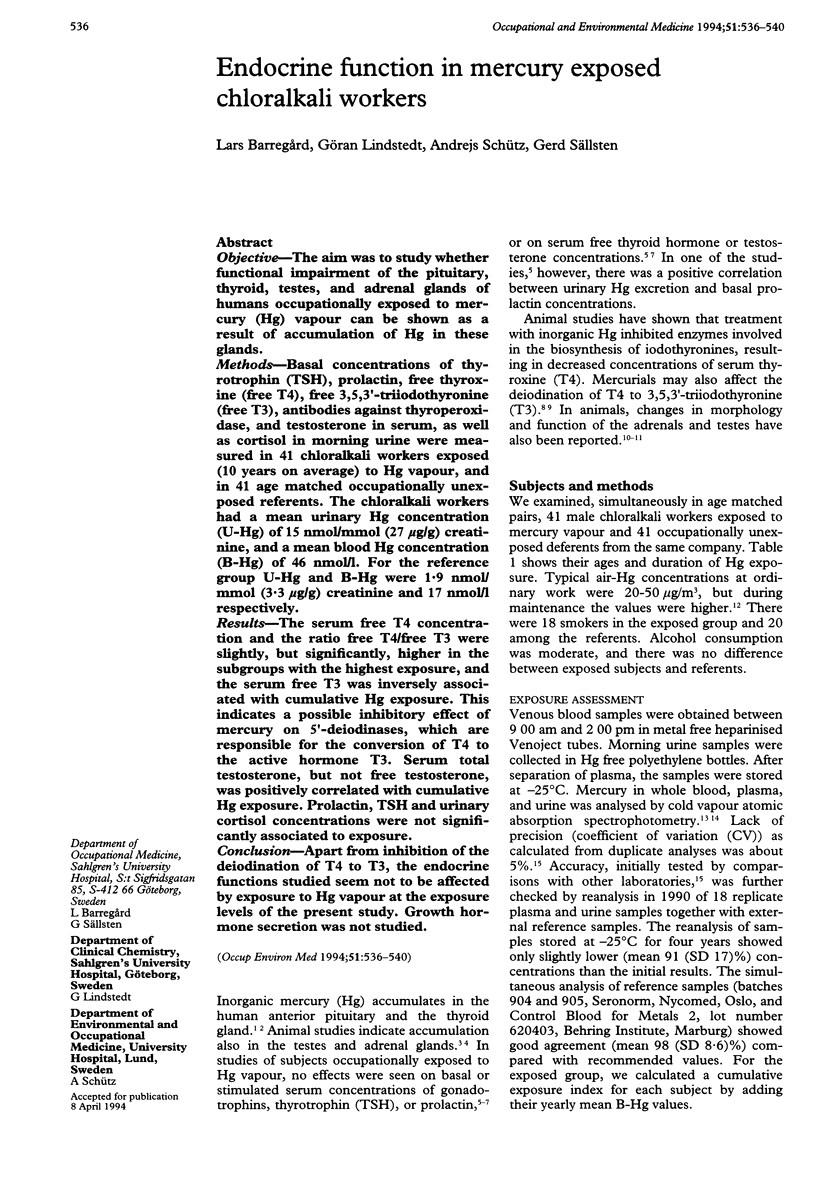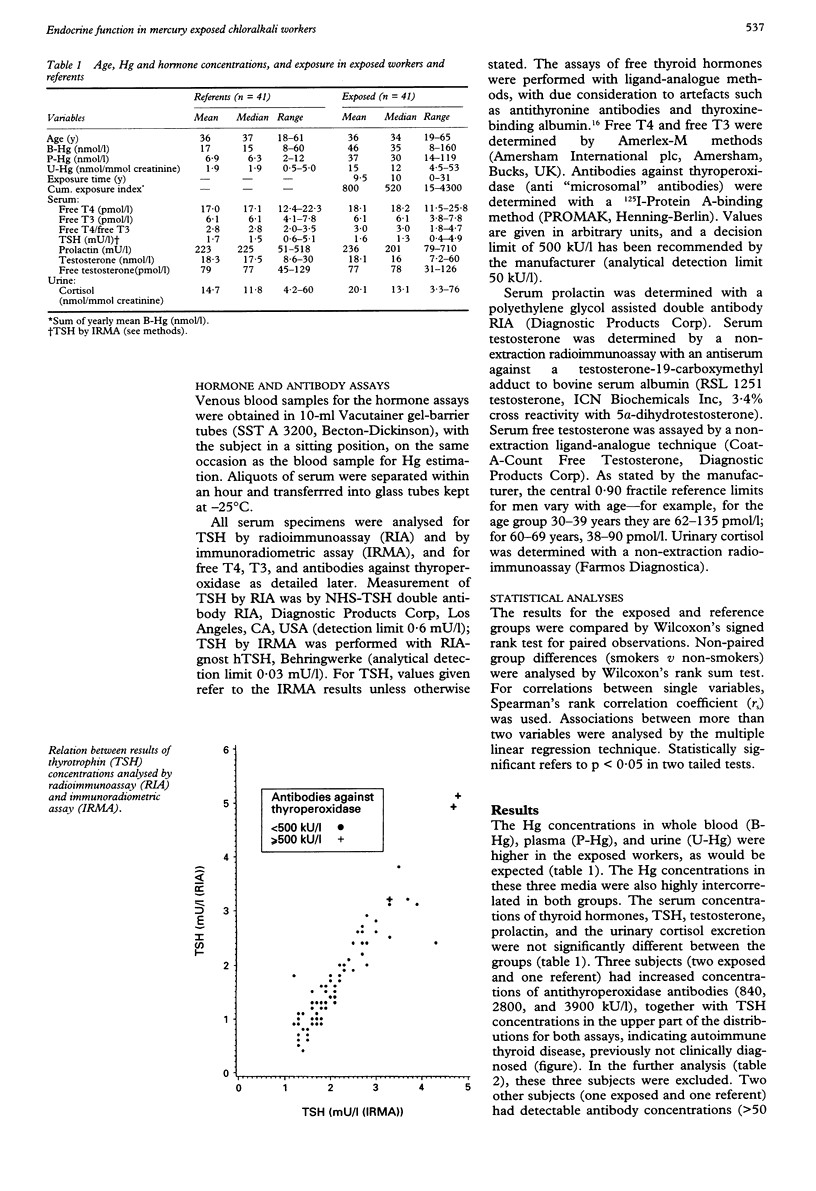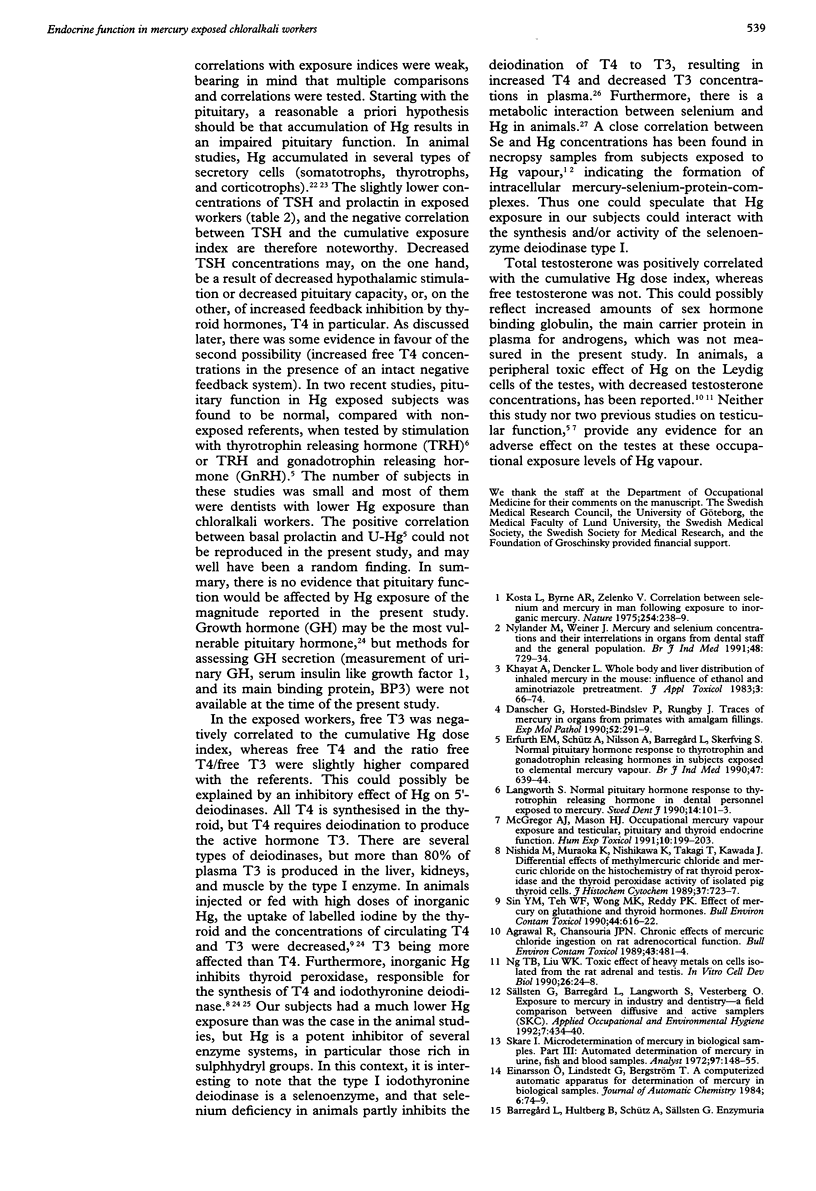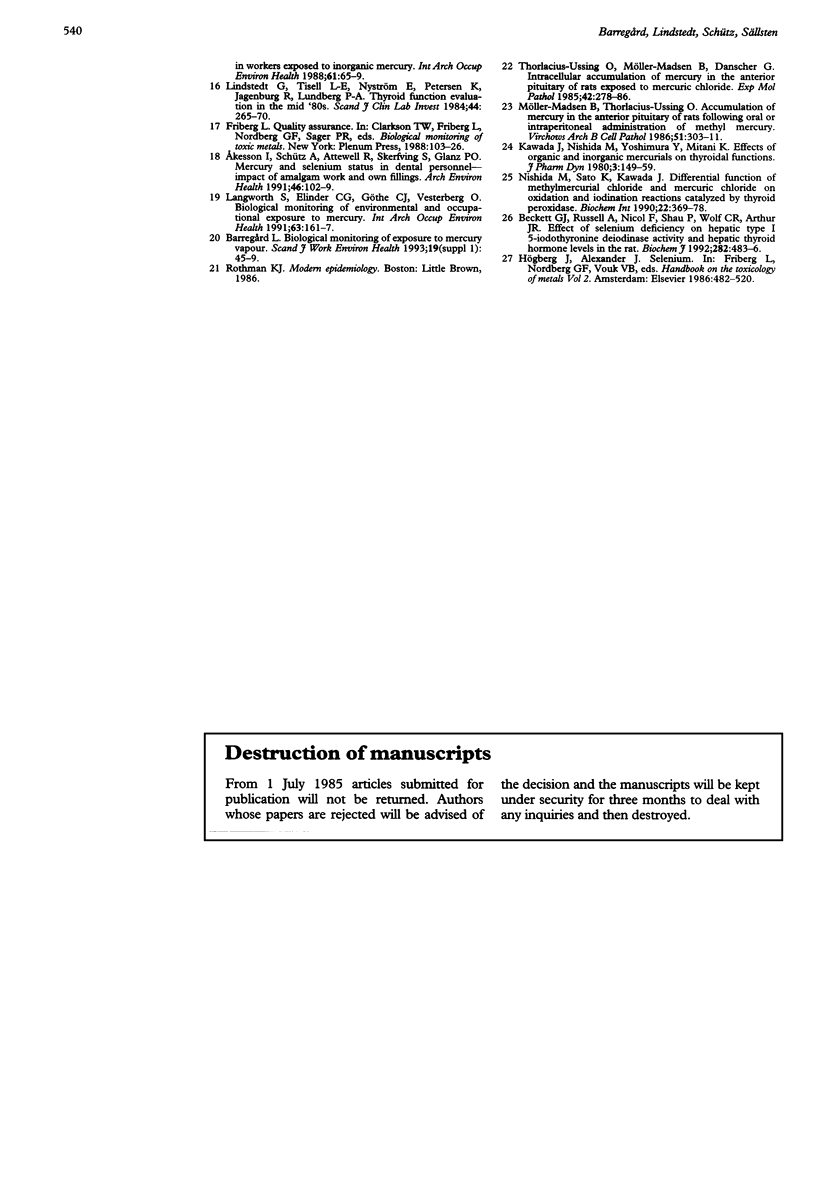Abstract
OBJECTIVE--The aim was to study whether functional impairment of the pituitary, thyroid, testes, and adrenal glands of humans occupationally exposed to mercury (Hg) vapour can be shown as a result of accumulation of Hg in these glands. METHODS--Basal concentrations of thyrotrophin (TSH), prolactin, free thyroxine (free T4), free 3,5,3'-triiodothyronine (free T3), antibodies against thyroperoxidase, and testosterone in serum, as well as cortisol in morning urine were measured in 41 chloralkali workers exposed (10 years on average) to Hg vapour, and in 41 age matched occupationally unexposed referents. The chloralkali workers had a mean urinary Hg concentration (U-Hg) of 15 nmol/mmol (27 micrograms/g) creatinine, and a mean blood Hg concentration (B-Hg) of 46 nmol/l. For the reference group U-Hg and B-Hg were 1.9 nmol/mmol (3.3 micrograms/g) creatinine and 17 nmol/l respectively. RESULTS--The serum free T4 concentration and the ratio free T4/free T3 were slightly, but significantly, higher in the subgroups with the highest exposure, and the serum free T3 was inversely associated with cumulative Hg exposure. This indicates a possible inhibitory effect of mercury on 5'-deiodinases, which are responsible for the conversion of T4 to the active hormone T3. Serum total testosterone, but not free testosterone, was positively correlated with cumulative Hg exposure. Prolactin, TSH and urinary cortisol concentrations were not significantly associated to exposure. CONCLUSION--Apart from inhibition of the deiodination of T4 to T3, the endocrine functions studied seem not to be affected by exposure to Hg vapour at the exposure levels of the present study. Growth hormone secretion was not studied.
Full text
PDF




Selected References
These references are in PubMed. This may not be the complete list of references from this article.
- Agrawal R., Chansouria J. P. Chronic effects of mercuric chloride ingestion on rat adrenocortical function. Bull Environ Contam Toxicol. 1989 Sep;43(3):481–484. doi: 10.1007/BF01701886. [DOI] [PubMed] [Google Scholar]
- Barregård L. Biological monitoring of exposure to mercury vapor. Scand J Work Environ Health. 1993;19 (Suppl 1):45–49. [PubMed] [Google Scholar]
- Barregård L., Hultberg B., Schütz A., Sällsten G. Enzymuria in workers exposed to inorganic mercury. Int Arch Occup Environ Health. 1988;61(1-2):65–69. doi: 10.1007/BF00381609. [DOI] [PubMed] [Google Scholar]
- Beckett G. J., Russell A., Nicol F., Sahu P., Wolf C. R., Arthur J. R. Effect of selenium deficiency on hepatic type I 5-iodothyronine deiodinase activity and hepatic thyroid hormone levels in the rat. Biochem J. 1992 Mar 1;282(Pt 2):483–486. doi: 10.1042/bj2820483. [DOI] [PMC free article] [PubMed] [Google Scholar]
- Danscher G., Hørsted-Bindslev P., Rungby J. Traces of mercury in organs from primates with amalgam fillings. Exp Mol Pathol. 1990 Jun;52(3):291–299. doi: 10.1016/0014-4800(90)90070-t. [DOI] [PubMed] [Google Scholar]
- Erfurth E. M., Schütz A., Nilsson A., Barregård L., Skerfving S. Normal pituitary hormone response to thyrotrophin and gonadotrophin releasing hormones in subjects exposed to elemental mercury vapour. Br J Ind Med. 1990 Sep;47(9):639–644. doi: 10.1136/oem.47.9.639. [DOI] [PMC free article] [PubMed] [Google Scholar]
- Kawada J., Nishida M., Yoshimura Y., Mitani K. Effects of organic and inorganic mercurials on thyroidal functions. J Pharmacobiodyn. 1980 Mar;3(3):149–159. doi: 10.1248/bpb1978.3.149. [DOI] [PubMed] [Google Scholar]
- Khayat A., Dencker L. Whole body and liver distribution of inhaled mercury vapor in the mouse: influence of ethanol and aminotriazole pretreatment. J Appl Toxicol. 1983 Apr;3(2):66–74. doi: 10.1002/jat.2550030203. [DOI] [PubMed] [Google Scholar]
- Kosta L., Byrne A. R., Zelenko V. Correlation between selenium and mercury in man following exposure to inorganic mercury. Nature. 1975 Mar 20;254(5497):238–239. doi: 10.1038/254238a0. [DOI] [PubMed] [Google Scholar]
- Langworth S., Elinder C. G., Göthe C. J., Vesterberg O. Biological monitoring of environmental and occupational exposure to mercury. Int Arch Occup Environ Health. 1991;63(3):161–167. doi: 10.1007/BF00381563. [DOI] [PubMed] [Google Scholar]
- Langworth S., Röjdmark S., Akesson A. Normal pituitary hormone response to thyrotrophin releasing hormone in dental personnel exposed to mercury. Swed Dent J. 1990;14(2):101–103. [PubMed] [Google Scholar]
- McGregor A. J., Mason H. J. Occupational mercury vapour exposure and testicular, pituitary and thyroid endocrine function. Hum Exp Toxicol. 1991 May;10(3):199–203. doi: 10.1177/096032719101000309. [DOI] [PubMed] [Google Scholar]
- Møller-Madsen B., Thorlacius-Ussing O. Accumulation of mercury in the anterior pituitary of rats following oral or intraperitoneal administration of methyl mercury. Virchows Arch B Cell Pathol Incl Mol Pathol. 1986;51(4):303–311. doi: 10.1007/BF02899039. [DOI] [PubMed] [Google Scholar]
- Ng T. B., Liu W. K. Toxic effect of heavy metals on cells isolated from the rat adrenal and testis. In Vitro Cell Dev Biol. 1990 Jan;26(1):24–28. doi: 10.1007/BF02624150. [DOI] [PubMed] [Google Scholar]
- Nishida M., Muraoka K., Nishikawa K., Takagi T., Kawada J. Differential effects of methylmercuric chloride and mercuric chloride on the histochemistry of rat thyroid peroxidase and the thyroid peroxidase activity of isolated pig thyroid cells. J Histochem Cytochem. 1989 May;37(5):723–727. doi: 10.1177/37.5.2703707. [DOI] [PubMed] [Google Scholar]
- Nishida M., Sato K., Kawada J. Differential effects of methylmercuric chloride and mercuric chloride on oxidation and iodination reactions catalyzed by thyroid peroxidase. Biochem Int. 1990 Oct;22(2):369–378. [PubMed] [Google Scholar]
- Sin Y. M., Teh W. F., Wong M. K., Reddy P. K. Effect of mercury on glutathione and thyroid hormones. Bull Environ Contam Toxicol. 1990 Apr;44(4):616–622. doi: 10.1007/BF01700885. [DOI] [PubMed] [Google Scholar]
- Skare I. Microdetermination of mercury in biological samples. 3. Automated determination of mercury in urine, fish and blood samples. Analyst. 1972 Feb;97(151):148–155. doi: 10.1039/an9729700148. [DOI] [PubMed] [Google Scholar]
- Thorlacius-Ussing O., Møller-Madsen B., Danscher G. Intracellular accumulation of mercury in the anterior pituitary of rats exposed to mercuric chloride. Exp Mol Pathol. 1985 Apr;42(2):278–286. doi: 10.1016/0014-4800(85)90034-6. [DOI] [PubMed] [Google Scholar]


